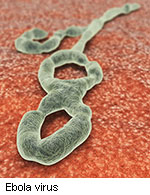
THURSDAY, Aug. 28, 2014 (HealthDay News) — Genetic research performed during the early days of the Ebola outbreak in West Africa has given scientists unprecedented insight into how the virus mutates and spreads.
Researchers report in the Aug. 28 online issue of Science that they have now determined the following:
- The Ebola strains responsible for the current outbreak likely have a common ancestor, dating back to the very first recorded outbreak of Ebola in central Africa in 1976.
- The virus is spreading from person-to-person, an insight that will help guide public health efforts to quell the outbreak.
- Ebola has mutated often during the current crisis, undergoing hundreds of genetic changes that separate the current virus from strains detected in previous outbreaks.
The researchers’ efforts have quadrupled the amount of genetic data available on Ebola, creating mounds of new and publicly available information about the DNA structure of the deadly virus, said senior study author Dr. Pardis Sabeti.
Sabeti is a senior associate member at the Broad Institute of MIT and Harvard and an associate professor at Harvard University.
The ongoing Ebola outbreak has infected 3,069 people and claimed the lives of 1,552, according to the World Health Organization.
The genetic researchers rapidly sequenced and analyzed more than 99 Ebola viruses from 78 patients in Sierra Leone during the first 24 days of the outbreak there.
Government health officials traced the entrance of Ebola into Sierra Leone to the burial of a traditional healer who had treated patients in neighboring Guinea. Thirteen women who attended the burial contracted Ebola, and researchers drew viral samples from these women to begin genetic sequencing.
Such genetic data is comparable to “fingerprints at the scene of the crime,” said Dr. Lee Norman, chief medical officer of the University of Kansas Hospital.
“It tells you so much about how and where the virus came from, and what we can do about it,” Norman said.
The team has found more than 300 genetic changes that make the 2014 Ebola virus distinct from the strains tied to previous Ebola outbreaks.
They also have found evidence that the Ebola outbreak started from a single introduction into humans, and has subsequently spread from person to person over many months. Animals are not helping spread Ebola.
“This is very important, because if you’re trying to contain an outbreak that’s coming in through an animal population, you have to do something about human contact with those animals,” said Dr. Robert Amler, dean of the School of Health Sciences and Practice and dean of the Institute of Public Health at New York Medical College.
Knowing that the virus is only spreading from human-to-human will help public health workers use time-tested isolation and quarantine procedures to protect people against further spread, Amler said.
“The basic principles of disease control in a population still hold,” he said. “That’s reassuring, because we have a lot of experience in controlling disease outbreaks in densely populated areas, and those principles hold.”
The researchers involved in this effort have publicly released all of the Ebola genetic information they’ve gathered, making it available through a U.S. National Institutes of Health database starting in June, Sabeti said.
This huge amount of genetic information regarding the virus hopefully will help spur and direct new research into therapies, vaccines and treatments for Ebola, Sabeti said.
“A lot of important findings that will come out of data will not come from us, but from others,” Sabeti said, noting that some of the world’s leading epidemic specialists are now working with the data they gathered.
Norman hailed the “integrity” behind making the genetic data available to the global health community.
“Releasing the DNA sequence into the public domain is just the right thing to do,” he said. “That shows an altruistic intent, which is perfect for something as heart-rending as this outbreak has been.”
The researchers involved in this effort have been tracking lethal viruses in West Africa since the middle of the last decade, initially focusing on the Lassa virus, Sabeti said.
When the ongoing Ebola outbreak began in Guinea, they were perfectly positioned to set up shop in Sierra Leone and start watching for the first cases there.
“We’ve built a lot of capacity to work with these deadly viruses in these rural areas,” Sabeti said. “We had surveillance going for months before the first case came in, and of course that first case led to a devastating cascade.”
More information
For more about Ebola virus, visit the U.S. Centers for Disease Control and Prevention.
Copyright © 2025 HealthDay. All rights reserved.

